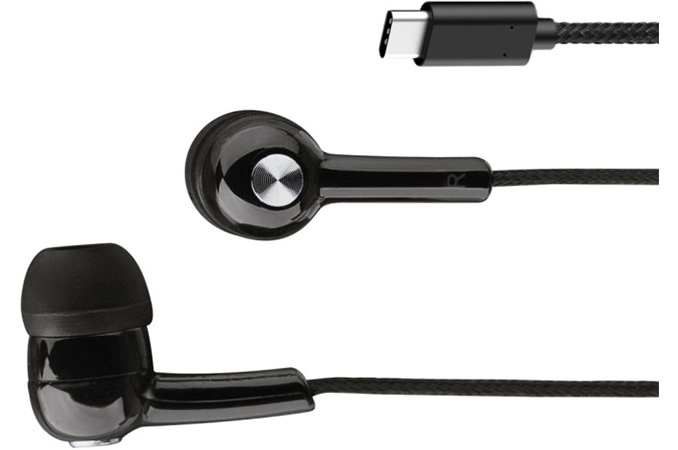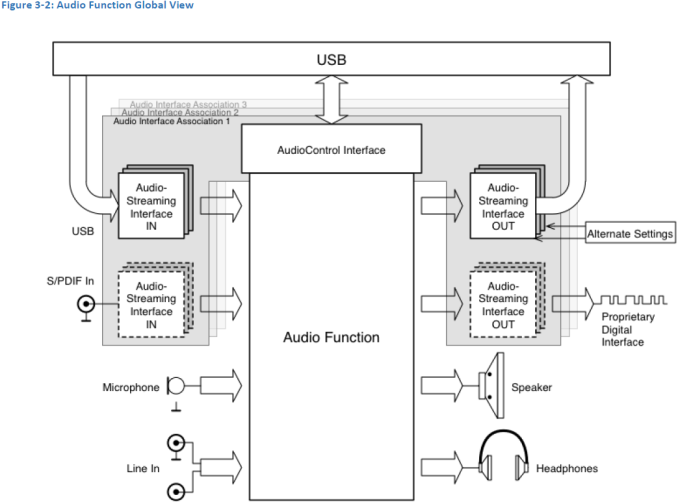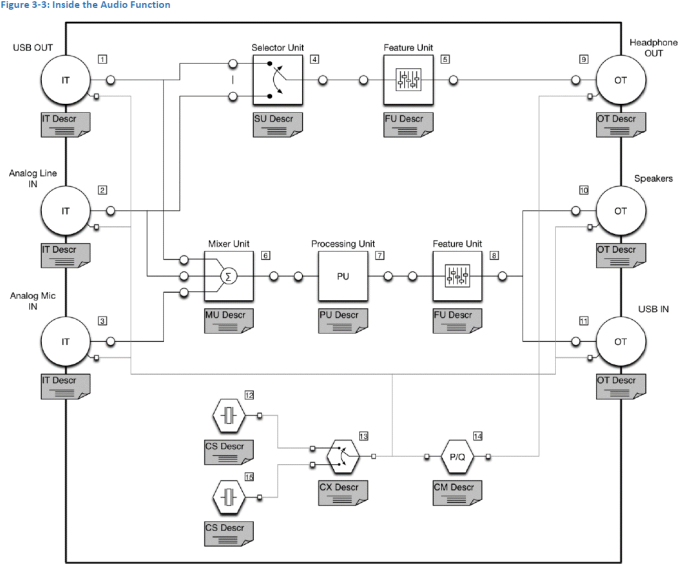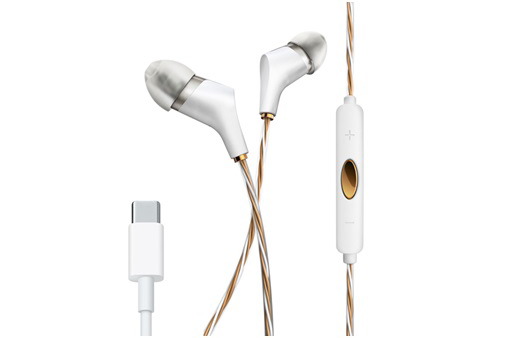USB-IF Publishes Audio over USB Type-C Specifications
by Anton Shilov on September 30, 2016 12:00 PM EST- Posted in
- Mobile
- USB-C
- USB-C Digital Audio

The USB Implementers Forum this week published the USB Audio Device Class 3.0 specification, which standardizes audio over USB Type-C interface. The new spec enables hardware makers to eliminate traditional 3.5mm mini-jacks from their devices and use USB-C ports to connect headsets and other audio equipment. Makers of peripherals can also build their audio solutions, which use USB-C instead of traditional analog connectors. Developers of the standard hope that elimination of mini-jacks will help to make devices slimmer, smarter and less power hungry.
The industry, led by Intel and some other companies, has been mulling about replacing the traditional 3.5mm mini-jack connector for some time now. The main motives for replacement were necessity to simplify internal architecture of devices by removing analog and some audio processing components from the inside (which leads to further miniaturization), minimize the number of external connectors, improve power management as well as to add smart features to headsets and other audio equipment. We discussed USB Type-C Audio Technology briefly earlier this year and mentioned that this is not the first time that the industry has tried to use USB instead of the good-old mini-jack. The important difference between contemporary initiative and attempts in the past is the fact that today the primary goal is to replace the 3.5mm jack in portable devices.
As reported, the USB Audio Device Class 3.0 specification supports both analog and digital audio. Analog audio is easy to implement and it does not impact data transfers and other functionality of USB-C cables since it uses the two secondary bus (SBU) pins. Some device makers may find the analog audio feature of the standard to be a relatively simple way to add certain smart capabilities to their headsets without major redesign of hosts. While analog USB-C audio will not help to shrink dimensions of portables, it could be particularly useful for non-mobile devices, where miniaturization is not crucial, but where port space is at a premium or where additional features either make sense (infotainment, sport equipment, etc.) or are fundamental (VR HMDs).
The USB ADC 3.0 defines minimum interoperability across analog and digital devices in order to avoid confusion of end-users because of incompatibility. In fact, all ADC 3.0-compliant hosts should support the so-called headset adapter devices, which allow to connect analog headsets to USB-C. However, digital audio is one of the primary reasons why companies like Intel wanted to develop the USB-C audio tech in the first place, hence, expect them to promote it.
According to the USB ADC 3.0 standard, digital USB-C headphones will feature special multi-function processing units (MPUs), which will, to a large degree, define the feature set and quality of headsets. The MPUs will handle host and sink synchronization (this is a key challenge for digital USB audio), digital-to-analog conversion, low-latency active noise cancellation, acoustic echo canceling, equalization, microphone automatic gain control, volume control and others. Such chips will also contain programmable amplifiers and pre-amplifiers, which are currently located inside devices. Besides, USB ADC 3.0-compatible MPUs will also support USB Audio Type-III and Type-IV formats (the latest compressed formats), but will retain compatibility with formats supported by ADC 1.0 and 2.0. Finally, among the mandated things set to be supported by USB-C Audio devices are new Power Domains (allows devices to put certain domains in sleep mode when not in use) as well as BADD (basic audio device definition) 3.0 features for saving power and simplified discovery and management of various audio equipment (each type of devices has its own BADD profile).
Over the past few months, Conexant has introduced three USB-C Audio MPUs (1, 2) for headsets, docking stations and other equipment. Assuming that these chips are compliant with the USB ADC 3.0 specs from a hardware standpoint, and the software is ready, actual devices featuring USB-C Audio could arrive in the coming months. Pricing of the first USB ADC 3.0-compliant MPUs is unknown, but in general MPU ICs do not cost too much. Moreover, as developers adopt smaller process technologies and a larger number of such chips hit the market, their prices are going to decline. In the end, it will be interesting to see where digital headphone prices end up. The MPUs will definitely add to the total bill of materials for a set of headphones, but at the same time they add new functionality as well, so the big question is how manufacturers then factor all of that into device pricing.
A number of companies, including Apple and LeEco, have already introduced smartphones that do not use traditional mini-jacks, and Google added support for USB DAC devices to Android over a year ago. The finalization of the USB ADC 3.0 spec, introduction of USB-C audio ICs, as well as design decisions of smartphone makers demonstrate that the industry is trying to eliminate 3.5mm jacks from mobile devices. The big question is whether the rest of the industry plans to do the same. It is true that portables are primary devices for music listening for many people. However, there are tens of applications which still rely on analog connectors, and hundreds of millions of people who use them either to consume or create content. To eradicate 3.5mm jacks completely, USB-C Audio promoters will have to work with thousands of vendors and this takes time. Consequently, it is too early to say that this is the end for the good-old mini-jack.
Images by Conexant, USB IF.
Source: USB IF













93 Comments
View All Comments
Communism - Friday, September 30, 2016 - link
Enjoy buying new headphones every year once your old ones are obsolete :DHave the "courage" to embrace progress :D
Xanavi - Friday, September 30, 2016 - link
You can pry my 3.5mm from my cold, dead hands!zeeBomb - Friday, September 30, 2016 - link
(looks at OnePlus)HomeworldFound - Friday, September 30, 2016 - link
It would be nice to have a standard like this. Since optical has gone there's been an annoying gulf in PC audio/speaker setups. I've not seen a single set of 5.1 or 7.1 PC speakers supporting HDMI input/output.MobiusStrip - Saturday, October 1, 2016 - link
Why would the SPEAKERS support this? You're going to string big-ass HDMI cables all around your room to every speaker?melgross - Saturday, October 1, 2016 - link
Again guys, the long term is wireless. That going to be the end. It's happening already.The whole concept is streaming the music from your phone in digital to you headphones where the conversion will be done with a higher quality DAC and amp, if you buy a better quality headphone.
Right now, you're at the mercy of the 25 cent DAC and 25 cent amp chip in your phone. Neither will be required for digital output.
mathew7 - Saturday, October 1, 2016 - link
"[....] if you buy a better quality headphone.""Right now, you're at the mercy of the 25 cent DAC and 25 cent amp chip in your phone. Neither will be required for digital output."
So, now you will need a DAC and AMP for EACH headphone and external speakers you use, if you want wired. And the price of those devices will be low (cause maybe 1% will pay for expensive devices)......so instead of most listeners using just crap speakers/headphones, they will now add crap DACs also.
There was also mentioned in the article about sync issues....so if your headphones have a cheap DAC with a wrong clock compared to the phone panel, you will start getting desyncronization with your youtube video. Effects can go to clicks and pops and even one of them too fast (like the early japanese dubbed movies). 1% clock difference means 100ms drift /10s. I can spot 20-30ms drift watching guitar playing and 40-50ms with voice. I know about this problem a long time ago with video capture cards that used the sound card for audio. SW had to take care of sync....I ended up using a video camera with IEEE1394 output to record from VHS.
As for power....those external DACs still need power and wireless consumes even more. The only difference is the detection, which any benchmarks will see the difference as test enviroment tolerance.
So the only reasons I can still see are:
- removal of analog ports (which I saw a post about HDCP-like protections)
- space (which I will happily take a +.2mm, even 1mm thicker phone with the port)
- waterproofing (I DID NOT decide to buy the Z1 compact and Z5 compact because of their waterproofing)
which none are customer-advantageous with the port removed.
MattMe - Monday, October 3, 2016 - link
I'm pretty sure the 3.5mm TRS is one of the easiest ports to make waterproof, so citing that as a reason to remove it doesn't make any sense.Mythbinder - Saturday, October 1, 2016 - link
Wireless is unreliable by nature and more wireless devices will just make the situation worse.Impulses - Saturday, October 1, 2016 - link
Headphones won't feature significantly better DAC/amp solutions anytime soon, you're terribly mis informed about the intricacies of headphone design and what's really possible...Never mind the duplication of components like batteries, and the fact that sealed batteries will lead to disposable designs when otherwise a really solid pair of headphones can last a decade or two...
Or the fact that everything begins ten times a hard to implement on in ear headphones or buds. You really think something the size of an eraser head has more room for high end audio componentes than a phone?
Get real, dyed in the wool audiophiles would just use an external amp/DAC box (which was already possible without Type C btw, and many did); though it's not really worth the effort if you're truly mobile and either at the mercy of background noise or simply not concentrated on the music.
For everyone else shifting and duplicating components around from one space constrained device to another even more space constrained device is a side grade at best... A money grab at worst.
It might enable some extra functionality, tho nothing that wasn't already possible via BLE which you yourself admitted is where we were heading... So why take away the wired option from people that don't wanna waste battery on wireless or why replace it with another wired standard?